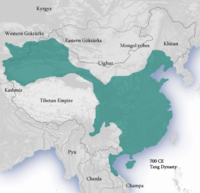Hexi Corridor

The Hexi Corridor (
As part of the
History
Early crop dispersal
Cultivated wheat, originating at the Fertile Crescent, appeared in China around 2800 BC at Donghuishan at the Hexi corridor. Several other crops are also attested at this time period. Xishanping is another similar site in Gansu.[2]
According to Dodson and coauthors (2013), wheat entered via the Hexi Corridor into southern Gansu around 3000 BC, although other scholars date this somewhat later.[1]
As early as the 1st millennium BCE, silk goods began appearing in Siberia, having traveled over the northern branch of the Silk Road, including the Hexi Corridor segment.[3]
Qin dynasty
At the end of the
Han dynasty

Protectorate of the Western Regions (Tarim Basin)
During the reign of
In
.During the
From roughly 115–60 BCE, Han forces fought the Xiongnu over control of the oasis city-states in the Tarim Basin. Han was eventually victorious and established the Protectorate of the Western Regions in 60 BCE, which dealt with the region's defense and foreign affairs.
During the
After the new Protector General of the Western Regions
Tang dynasty


The Tang dynasty fought the Tibetan Empire for control of areas in Inner and Central Asia. There was a long string of conflicts with Tibet over territories in the Tarim Basin between 670 and 692.
In 763 the Tibetans even captured the Tang capital of
Western Xia dynasty
The Western Xia dynasty was established in the 11th century by the Tangut people. Western Xia controlled from 1038 CE up to 1227 CE the areas in what are now the northwestern Chinese provinces of Gansu, Shaanxi, and Ningxia.
Yuan dynasty
Genghis Khan began the conquest of the Jin dynasty around 1207 and Ögedei Khan continued it after his death in 1227. The Jurchen-led Jin dynasty fell in 1234 CE with help from the Han-ruled Southern Song dynasty.
Ögedei also conquered the Western Xia dynasty in 1227, pacifying the Hexi Corridor region, which was later absorbed into the Yuan dynasty.
Geography and climate
The Hexi Corridor is a long, narrow passage stretching for some 1,000 kilometres (620 mi) from the steep
A strikingly inhospitable environment surrounds this chain of oases: the snow-capped
Geologically, the Hexi Corridor belongs to a Cenozoic foreland basin system on the northeast margin of the Tibetan Plateau.[7]

The ancient
There are several major cities along the Hexi Corridor. In western
The Jiayuguan fort guards the western entrance to China. It is located in
See also
References
Citations
- ^ PMID 27942165.
- S2CID 55810068.
- ^ Silk Road, North China, C.Michael Hogan, the Megalithic Portal, ed. A. Burnham
- ^ "Dunhuang History". Retrieved 2009-06-12.
- ^ Barnes (2007), p. 63.
- ISBN 9868141982
- .
- ^ "The Silk Roads and Eurasian Geography". Retrieved 2007-08-06.
Sources
- Barnes, Ian (2007). Mapping History: World History. London: Cartographica. ISBN 978-1-84573-323-0.
- Yap, Joseph P. (2009), Wars With The Xiongnu: A Translation From Zizhi tongjian. AuthorHouse, ISBN 978-1-4490-0605-1.
- Yap, Joseph P. (2019), The Western Regions Xiongnu and Han: From the Shiji, Hanshu and Hou Hanshu. ISBN 978-1-79282-915-4
